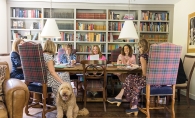In December, Edina physician Jim Rohde made his 12th pilgrimage to Haiti as a volunteer. And this trip was special. Rohde dedicated the final piece of a seven-years-long medical building project, which he coordinated in partnership with Healing Hands for Haiti, an international nonprofit.
Edina Magazine talked with Rohde about his passion for global medicine and his newfound role as a construction project manager—a hands-on labor of love.
A Happy Accident
On Rohde’s first visit to Haiti, he figured it would be a one-time trip. The Edina physician got connected with Healing Hands for Haiti by a happy accident. “It was totally a fluke,” Rohde remembers with a smile. “One of my patients came in to get [immunizations] before traveling to Haiti, and I asked him about why he was going.”
The patient, a filmmaker, explained that he was on his way to document the work of a nonprofit that provided physical rehabilitation for injured and disabled Haitians. He put Rohde in touch with Healing Hands, and in no time, the doctor was on a plane, headed for Port-au-Prince. “I volunteered and went down with them for the first time in 2005,” Rohde remembers, and then chuckles. “This December, I went for my 12th trip.”
Medical Mission
Although his 2005 Haiti trip came as something of a surprise, Rohde does have an impressive background as a physician abroad—and Healing Hands felt like a match made in heaven. “I twice went to Africa and worked as a medical student, and [again] after my internship as a medical missionary,” he explains. “That’s what drew me to medicine in the first place—doing international medicine.” Rohde has been a family physician for 38 years and has practiced with Edina Family Physicians since 1975. For years, he had been looking for the perfect opportunity to get back on the road. “Haiti was an answer to a long-term need that I had,” he offers. “A lot of people out there need their Haiti or some sort of organization to contribute to.”
Rohde also has a special place in his heart for rehab medicine, which is Healing Hands’ primary focus. “One of the special parts of my practice over 38 years has been taking care of a lot of disabled adults and children,” he says. “I was on staff at the [Twin Cities-based] Courage Center [now the Courage Kenny Rehabilitation Institute], and saw a lot of people with spinal cord injuries, cerebral palsy and multiple sclerosis … and that played a part in my getting involved with Healing Hands for Haiti.”
During that first trip to Port-au-Prince, Rohde immediately put his skills to use. On the first day, a family brought a paralyzed patient to Healing Hands’ clinic. “He’d broken his back. They’d driven him 150 miles and they carried him in on a lawn chair. By the end of the week, he was able to leave our clinic with a wheelchair, and had been rehabilitated.” Because most Haitians don’t have access to roomy hospitals or medical insurance, their care needs to be quick and efficient. “What I had seen [American medicine] do in six months, the team in Haiti had to do on the fly in about a week,” Rohde marvels.
Healing Hands
So, how did it all begin? Healing Hands for Haiti was founded in 1999 by Utah physician Jeff Randle, who coordinated an informal mission trip with some of his colleagues to provide rehab medicine. The organization gained support from donors and volunteers in several countries, and now sends hundreds of volunteers to Haiti each year. But Randle and his team weren’t content to send people power alone—in the early 2000s, Healing Hands opened its own clinic and prosthetic shop. The organization now serves thousands of patients each year.
After his first 2005 trip, Rohde traveled to Haiti frequently to provide medical care at the clinic. He worked closely with another Twin Cities physician, Dr. Steve Fisher, who’s a former president of Healing Hands. “[Steve] has been a huge part of the organization,” says Rohde. “He’s my role model, and we all need role models.”
In 2006, Healing Hands started looking for resources to build a new in-patient facility at its headquarters in Port-au-Prince. Rohde jumped in to help with the plans, and happened to meet Minneapolis architect Poul Bertelsen, whose team at MSAADA Architects has constructed more than 700 projects in developing countries around the world. “We got to be friends, and I asked him to be our architect in Haiti,” says Rohde.
“I really have appreciated working with Healing Hands,” says Bertelsen. “Jim is a very pleasant person to work with, because he’s so committed to his cause. That commitment makes it so exciting for everyone.”
As the construction planning began, Rohde moved away from his hands-on medical duties and became the facilities chairman on the board for the new buildings.
Earthquake Aftermath
On January 12, 2010, Haiti was thrust into turmoil and unimaginable tragedy by a 7.0-magnitude earthquake. Most of Port-au-Prince, including Healing Hands’ outpatient clinic, experienced major damage, and over 100,000 people were killed. Jim Rohde didn’t hesitate to pitch in. “I went down to Haiti about three months after the earthquake and worked a little bit in one of the MASH hospitals at the airport. After a disaster, it’s a totally different experience and need from the ongoing [day-to-day] need.”
As donors and volunteers flocked to Haiti to help after the earthquake, Rohde hoped that the renewed spirit of giving would continue even after the initial response. Today, he says, most of Haiti is back to some sort of “normal” after the earthquake, “but that’s where the majority of the need is in the world. It’s the day-to-day need, not the disasters. A disaster is a reminder that [need is] there, but Haitians needed us before the disaster, and they need us after the disaster is cleaned up.”
Rebuilding
After the earthquake, plans for Healing Hands’ new facility shifted. Instead of an in-patient space, the organization decided to construct three new buildings: an outpatient rehab clinic, an education center where local residents can receive training in physical therapy, prosthetics and other rehab disciplines, and a guesthouse for Healing Hands’ international volunteers. The guesthouse, the last of the buildings to be finished, opened in early December, and Jim Rohde was there to give it his blessing. He notes that the architects were especially sensitive to how the new buildings would fare in another earthquake. “They’re built to withstand anything Mother Nature sends their way.” Rohde is happy that he was able to connect Healing Hands with Poul Bertelsen’s team at MSAADA. In fact, he calls the connection “my greatest contribution to Haiti.”
Rohde himself can take no small credit for the beautiful new buildings. He focuses on ensuring funds are being used to build new facilities and to keep the board of directors on top of the project (he sits on Healing Hands’ board of directors). But he says that he has received more from Haiti than he has given. “It makes me appreciate how wonderful [life is] back here,” he says. “Having air conditioning, clean water, safe homes.”
“We’re blessed that [in America] we have the resources to give to so many different countries and areas of the world,” Rohde says. “You’re in Haiti and you’re meeting Minnesotans all over the place … It’s very rewarding, and I would say [a volunteer trip] has the potential of becoming the best and most important thing we do in our lives.”
To learn more about Healing Hands for Haiti and what you can do to help, visit healinghandsforhaiti.org.









